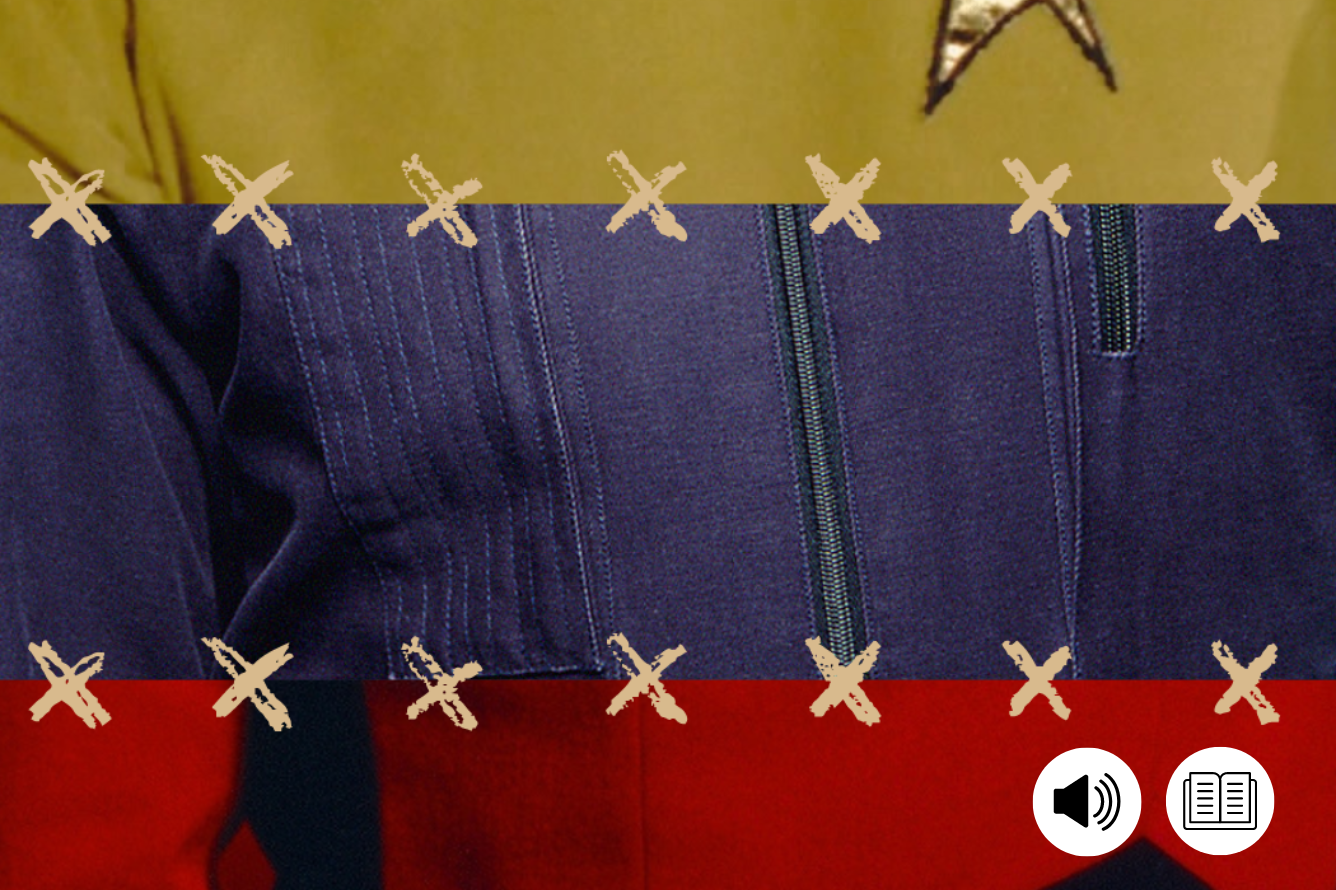It’s all too easy to assume that Star Trek – aka that same TV series which is primarily set in the future, ranging from the mid-22nd century (Star Trek: Enterprise) to the 32nd century (Star Trek: Discovery) – is as far removed from contemporary fashion trends as… well, as the M-33 Galaxy is from Earth. Which is, in case you’d forgotten, very very far away. Indeed, with M-33 positioned some 2.7 million lightyears away from its previous position in the Milky Way, it would take Enterprise some 300 years to travel home from there at maximum warp.
As ever, though, it seems to assume really is to make an ass of you and me. Because Star Trek – and by which I mean every single iteration of that iconic Starfleet-issue jumpsuit – has always been incredibly on-trend. Every. Single. Iteration.
As Harriet Hall, fashion expert, Lifestyle Editor at The Independent, and feminist author of She: A Celebration of Renegade Women, tells me:
“Even in a futuristic series like Star Trek, contemporary trends and styles are used to inspire the costumes.”
She adds: “This helps to create a ‘believable’ and ‘relatable’ sartorial basis for the future, allowing viewers to better immerse themselves in it.”
Star Trek: The Original Series Uniforms
With Hall’s comments in mind, it makes sense as to why the women of Star Trek: The Original Series decided to boldly go where no other woman on mainstream TV had gone before. By which I mean, of course, that they – in William Shatner’s words – frequently donned the “shortest skirts on television”.
“The 1960s marked the beginning of youth culture and the separation of teenagers and young adults from their parents’ generation in terms of interests, music, and clothing,” explains Hall.
“This feeling of liberation and independence through a rejection of the stringent conformity of their parents’ generation became known as ‘The Youthquake’. And, in the fashion world, this was reflected in a ‘bubble up’ approach to fashion, where trends no longer trickled down from the catwalk; instead, teenagers opted for identity-shaping styles which could be easily made at home using simple patterns.
Further Reading on Star Trek and Identity
Star Trek | Trill as Trans: Trek's Evolving Attitudes Toward Gender Variance
From TNG’s ‘The Host’ to DS9’s Jadzia Dax, and Discovery’s Adira and Gray Tal, Trill has been used as an imperfect allegory for the Trans experience.
“At the vanguard of this was British designer Mary Quant, who made simple mini-shift dresses inspired by the carefree styles of children’s wear – complete with little Peter Pan collars and bold graphic prints. And her Kings Road boutique, Bazaar, quickly became the locus for trendy young women wanting to express their sexual liberation through incredibly short miniskirts and thigh-high boots.”

In the years since the series first aired, of course, it’s become all too apparent that NBC requested the show’s female stars were decked out in revealing costumes – a revelation that has prompted many to look back on the series with barely-concealed scorn for its hyper-sexualization of women.
However, it’s worth noting that Nichelle Nichols – who played Nyota Uhura in the series – has publicly dismissed those that have suggested she was forced into wearing anything unusually short or revealing. Indeed, much as Hall has explained already, Nichols told the BBC that she was already “wearing [very short mini skirts] on the street. What’s wrong with wearing them on the air? I wore ’em on airplanes.
“It was the era of the miniskirt. Everybody wore miniskirts!”
While the women of Star Trek: The Original Series donned simplistic Quant-like tailoring and thigh-high hemlines, the men – Shatner included – donned brightly-colored and extremely skintight nylon shirts and charcoal slacks.
“It’s all about the subtle detailing here,” says Hall, noting that the men’s Mod haircuts were likely inspired by those worn by the decade’s most famous heartthrobs: The Beatles.
“Look at those slight V-necks and that gold trim,” she continues. “These were used to inject a more futuristic twist and a slightly ‘other’ aesthetic to the Starfleet uniform so that it doesn’t feel too grounded in reality.”
Star Trek: The Next Generation Uniforms
If you thought the Starfleet uniforms of the Star Trek: The Original Series series were revealing, take another gander at the costumes worn in Star Trek: The Next Generation.
Crafted from spandex, these one-piece suits were famously made to be one size too small – ostensibly for a smoother line on camera – and with no pockets. Which, when you’re seeking out new life and new civilizations, is about as useful as a chocolate teapot.

“We hated our space suits,” Geordie LaForge actor LeVar Burton famously declared. “As much as they call it a stretch fabric, spandex in that configuration doesn’t give all that much. It hid nothing.”
After two seasons of misery, the costume designers eventually swapped the spandex for a more forgiving woolen material. Still, though, they still kept silhouettes tight and shoulders seriously padded.
The result? A sort of inverted triangle silhouette – one which had become synonymous with the 80s.
“This was the same decade in which many women stepped out of the secretarial pool and entered the boardroom,” says Hall, “and they did so wearing bold power shoulders to exert their presence among the male-dominated workplaces.”

Further Reading on Marina Sirtis
14 Fiery Quotes from Marina Sirtis in our To Boldly Ask Video Interview
Star Trek royalty Marina Sirtis spills the Earl Grey on Deanna Troi, fighting for her voice, and why she left L.A. for London in To Boldly Ask…
It wasn’t just big shoulders and power dressing that influenced Star Trek: The Next Generation uniforms, though. As Hall points out, the 1980s was “also a time in which dance and aerobics dominated.
“Whoopi Goldberg looks like the ultimate disco queen in her shining crushed velvet and a futuristic hat that we can only imagine would be nothing but impractical in space.”
Meanwhile, the bodycon leotards worn by Marina Sirtis’s Deanna Troi look as if they were pulled “straight out of the popular Pineapple Dance Studio in Covent Garden!”

Close your eyes and imagine that Star Trek: The Next Generation uniform again. I know what you’re thinking; red for command, gold for operations, blue for sciences, raised collars, and rank insignia on the neckline.
So far, so sci-fi, right? But, as Hall points out, these uniforms were a twist on the hyper-tailored Nehru jacket – a style first popularised by the Indian Prime Minister Jawaharlal Nehru (1947-1964).
“This reflects the increasing globalization of fashion during the 80s,” she says, reminding me that the decade was – thanks to the stock exchange and leaders such as Regan and Thatcher – an era of boom, in which wealth was privatized and many experienced disposable incomes.
“Mind you, Star Trek has evolved the classic Nehru look into something more befitting a gymnast at the 1980 Olympics.”
Star Trek: Deep Space Nine Uniforms
We all know that Star Trek: Deep Space Nine is darker and grittier than the other Star Trek shows that came before it, so it makes sense that these hopepunk vibes are reflected in its twist on the Starfleet uniform.
Further Reading on Star Trek & Hopepunk
The Hopepunk Case for Deep Space Nine
Star Trek: Deep Space Nine has a reputation for darkness, but finding light in the dark is the definition of hopepunk.
More utilitarian than anything worn by the Star Trek: The Original Series and Star Trek: The Next Generation crew, the officers of Star Trek: Deep Space Nine opted for mostly black jumpsuits, with only the shoulders in red for command, gold for operations, and blue for sciences. The material was loose enough that they were able to roll their sleeves up (can you even imagine Miles O’Brien with his sleeves rolled down!?). And they often flashed their dystopic grey undershirts, too.

Commenting on how these pared-down styles reflected contemporary fashions at that time, Hall says: “In the West, the 1990s opened with economic crisis – which led to a recession, unemployment, and rioting. This discontent marked an abrupt end to a decade that saw gluttony from many and people’s attitudes to wealth changed dramatically.
“In the fashion world, this manifested as a staunch rejection of displays of wealth, and dress-down, anti-fashion and inconspicuous consumption became the norm with designers such as Norma Kamala, Donna Karen, Muccia Prada and Calvin Klein all opting for low-key minimalist sportswear… and in much darker colours.”









